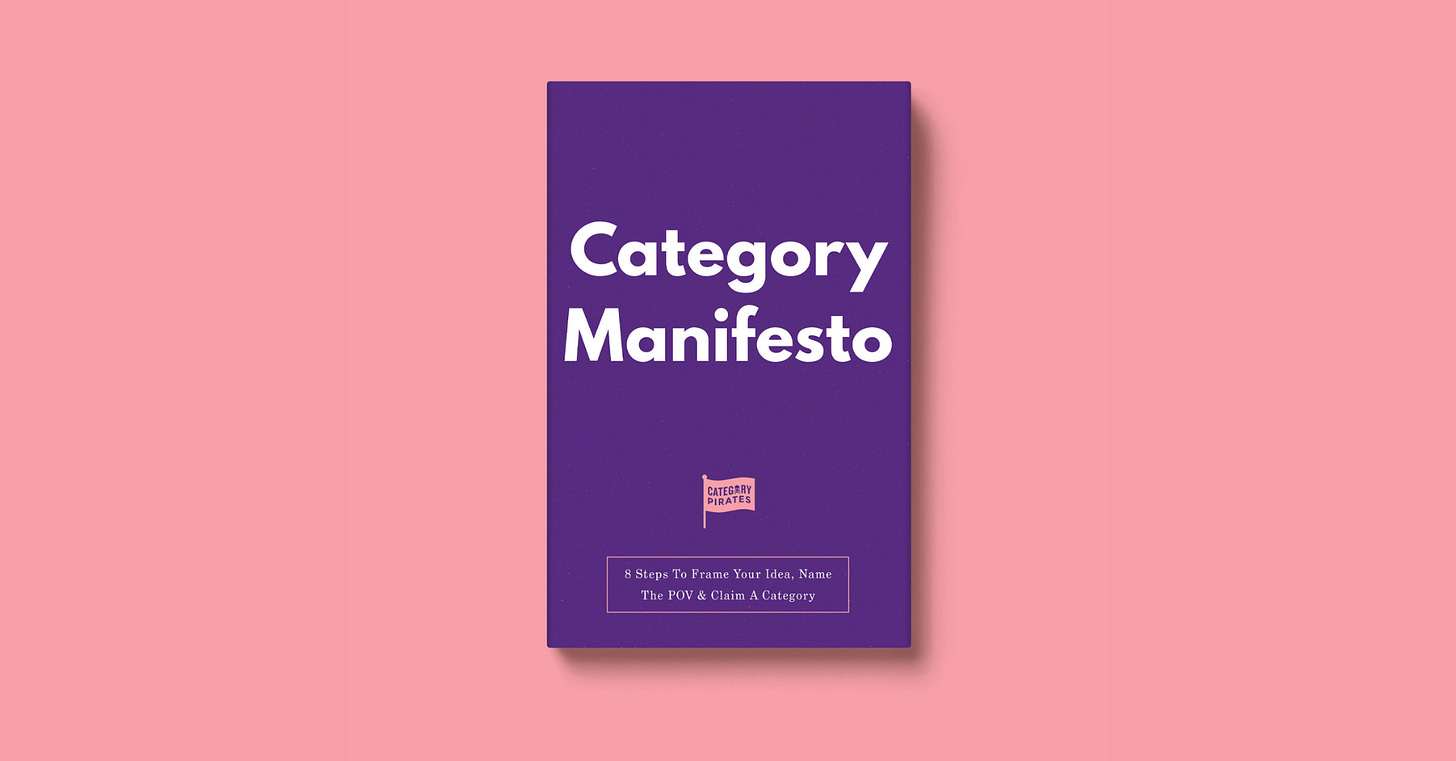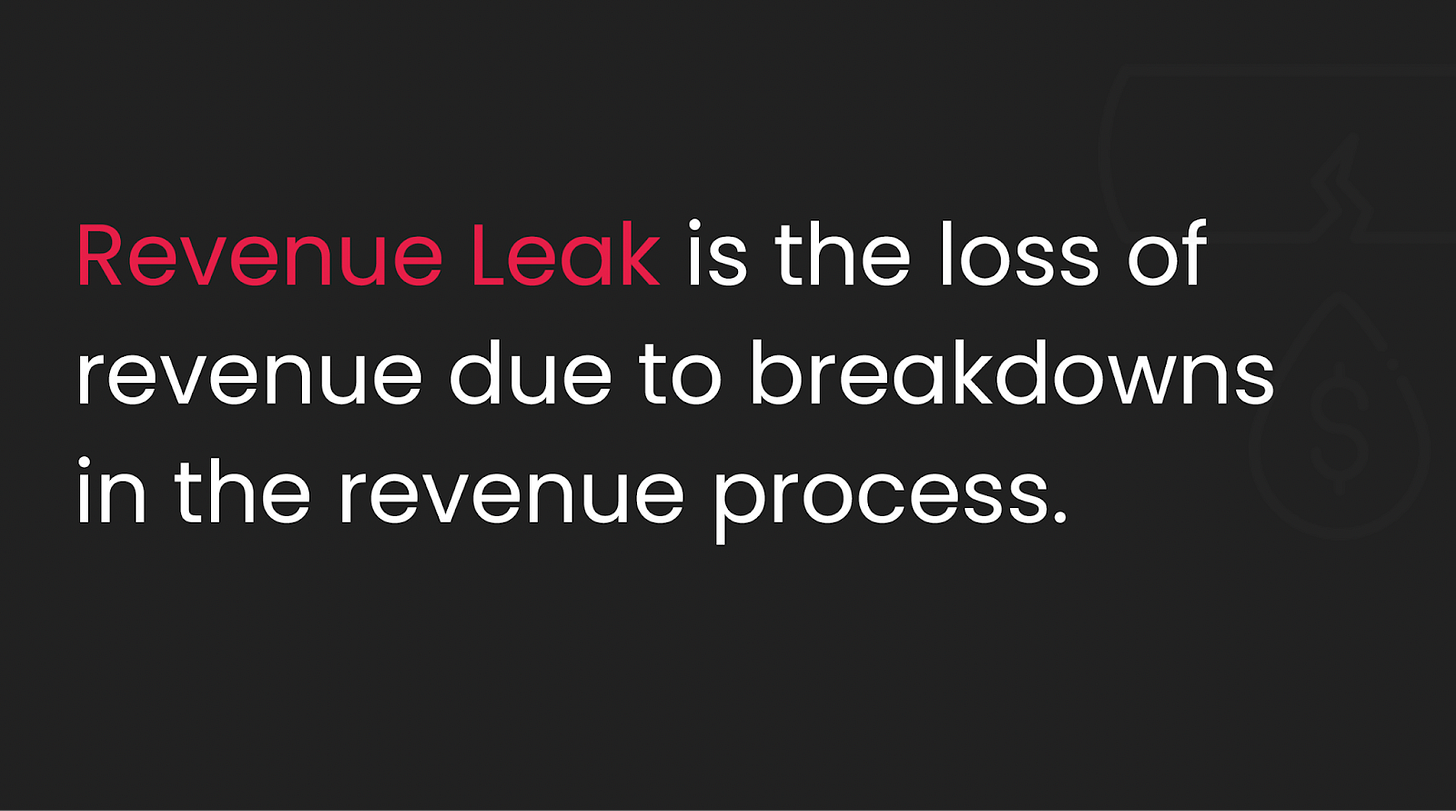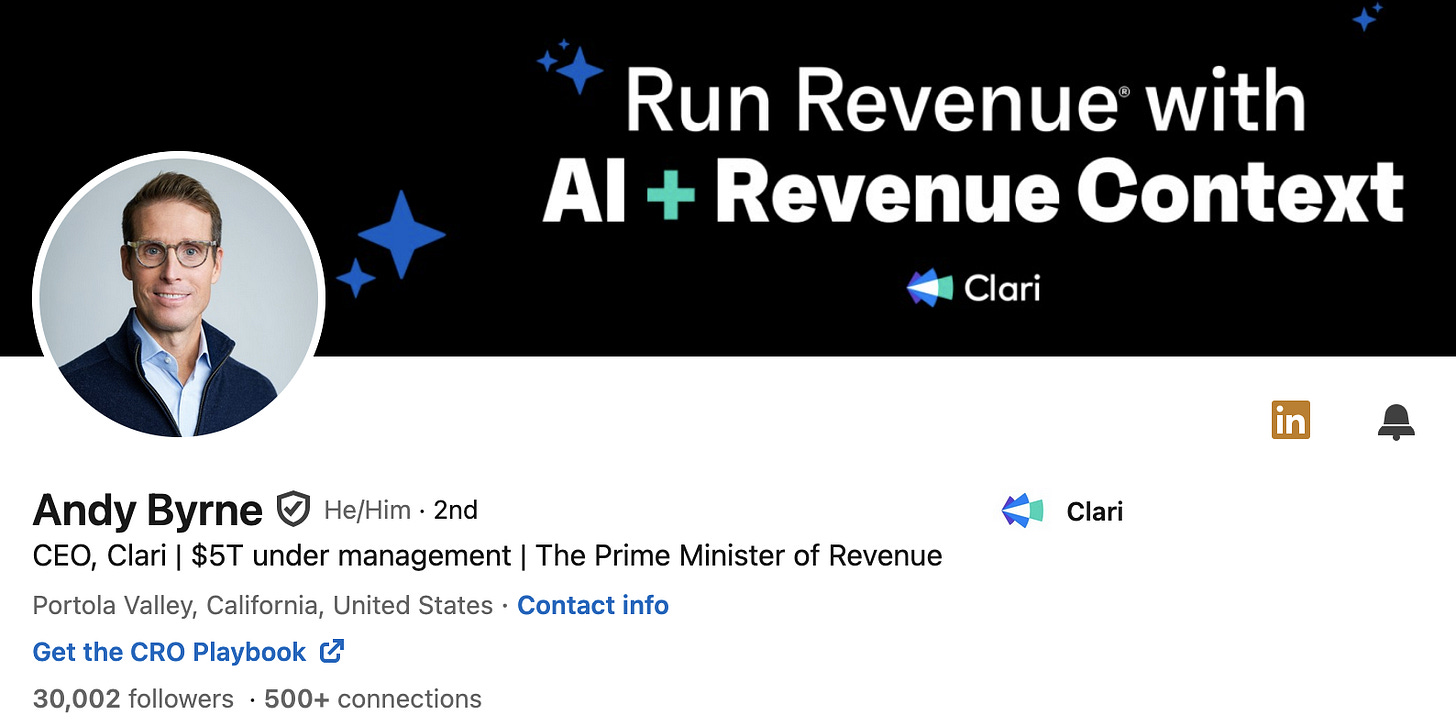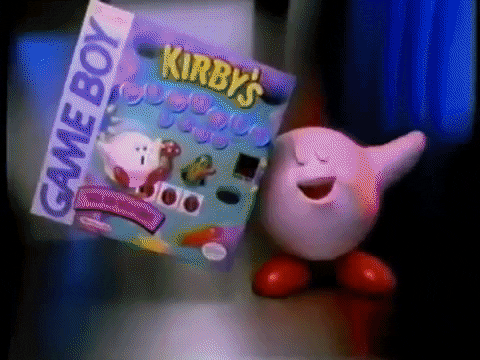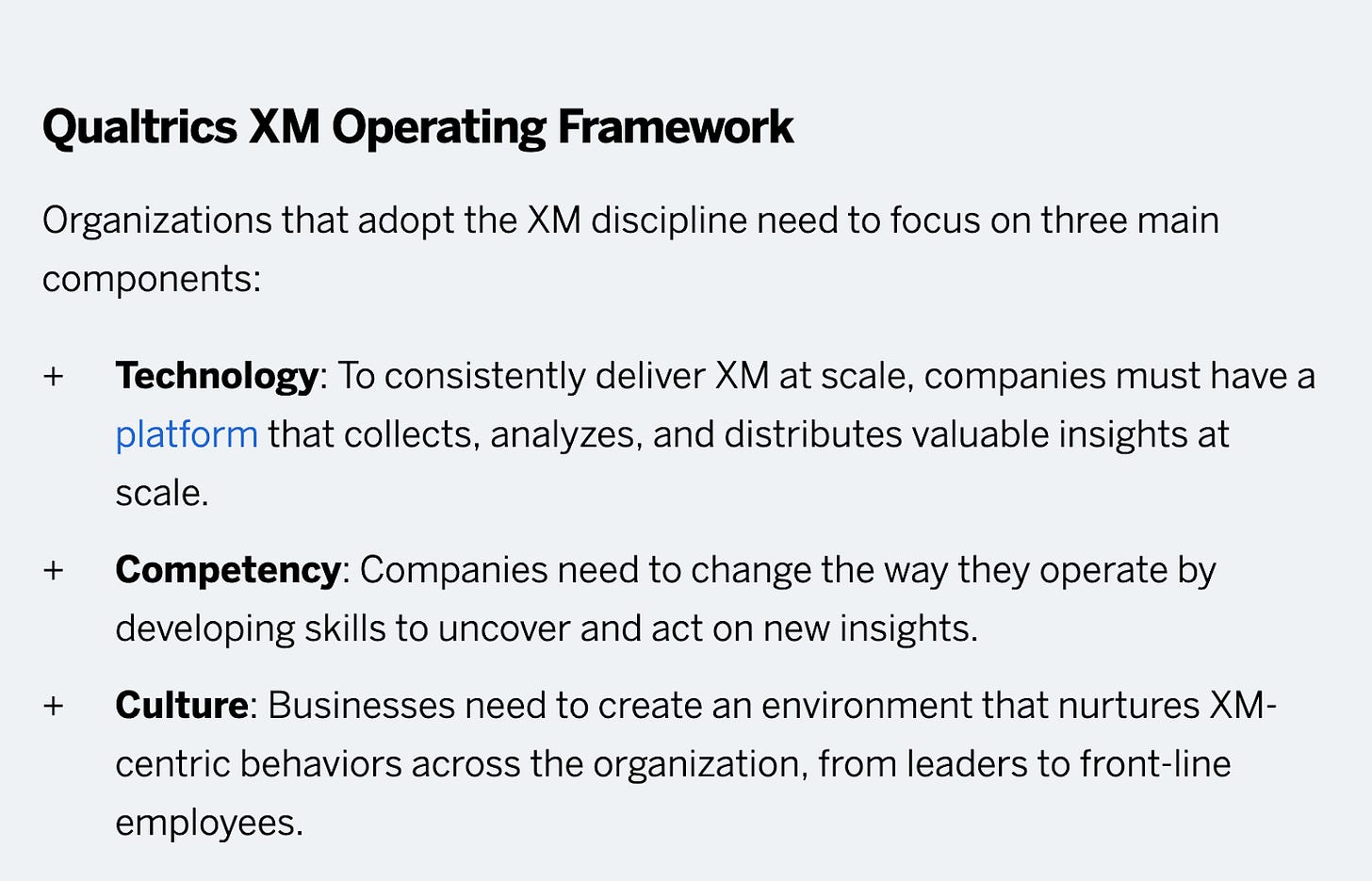Category Manifesto: 8 Steps To Frame Your Idea, Name The POV & Claim A Category
Create the rallying cry for your new category.
Arrrrr! 🏴☠️ Welcome to a 🔒 subscriber-only edition 🔒 of Category Pirates. Each week, we share radically different ideas to help you design new and different categories. For more: Dive into an audiobook, listen to a category design jam session, or upgrade to a Founding subscription to ask the Pirate Eddie Bot your category design questions.
Dear Friend, Subscriber, and Category Pirate,
In 2022, Clari (a B2B software company) became a Category King with one decision.
They weren’t the loudest. They didn’t have the flashiest tech. And they didn’t have the biggest market cap.
But they launched something most companies never do:
A category movement that changed the conversation.
In boardrooms and Slack channels, Clari heard revenue teams ask the same question.
“Will we hit our numbers?”
This question haunted sales leaders, kept CROs pacing before meetings, and made RevOps teams scramble to reconcile CRM fields no one updated. Every team had revenue dashboards, spreadsheets, and forecasts. But none of these addressed the question.
And Clari saw a deeper truth:
The revenue wasn’t missing—it was leaking.
Quietly. Invisibly. Across silos and disconnected systems.
Clari noticed this systemic blind spot. It wasn’t just a data issue or a process gap. It was a business-wide failure to govern the most important number on the P&L.
Instead of treating it like a workflow problem, Clari named, framed, and claimed a crisis:
“Revenue Leak.”
That moment forever changed the company and category.
Once you name a problem, people see it.
And once they see it, they can’t unsee it.
Clari launched a bold Category Manifesto backed by research to educate people about Revenue Leak.
They declared that revenue isn’t an outcome you track, it’s a process you run. It was the start of a movement. They declared war on the old way of running revenue. They showed how companies lost up to 15% of their revenue every year, not to churn or competition, but to misalignment.
Most importantly, they introduced a new way of thinking.
Revenue Leak became the enemy.
Revenue Precision became the goal.
Revenue Collaboration and Governance became the new solution.
Their Lightning Strike started with a powerful slide deck and a white paper.
Suddenly, Clari wasn’t just a software vendor.
It was the company that “Runs Revenue,” with a CEO as the Prime Minister of Revenue.
Clari now governs $5 trillion in revenue, the first revenue platform to reach this threshold.
It’s because Clari reframed the conversation. They planted a flag. And they gave every CEO, CRO, and RevOps leader a new lens for how to run the revenue process.
Not by being better.
But by being different and launching a Category Manifesto that:
Named their enemy – Revenue Leak
Framed a new POV – Revenue isn’t a result, you must run it
Developed a framework – Revenue Collaboration & Governance
Backed it with data – ROI studies and multi‑trillions under management
That manifesto did what marketing is supposed to do, but rarely does. It educated, evangelized, and built a mission-driven movement.
(Remember: Mercenary marketers chase demand. Missionary marketers create it.)
As a result, Clari created trillions of dollars of demand.
Becoming a Category King happens when you stop writing self-serving corporate marketing that screams ‘LOOK AT ME’ and create a Category Manifesto that says 'Look at the future.'
Every legendary category starts by framing, naming, and claiming a point of view.
But most companies struggle to articulate that "view."
That’s where Rob—a financial advisor for ultra-high-net-worth clients—was stuck. He had the clients. He had the right instincts. He even had an idea for the category name.
But he didn’t have a clear, ownable Category Manifesto to bring it all together.
That changed during a live Category Design Academy workshop.
We walked Rob through a live Vibe Creation session. He puked his raw thoughts about his category. We asked questions to pull out Rob’s knowledge and refine his language. And together (with Lucy, our custom ChatGPT), we outlined his Category Manifesto.
We jammed with him on:
Understanding his Superconsumers
Naming the shift in the market
Framing the trap most financial advisors fall into
Declaring a new and different Point of View
Positioning Rob as the leader of this new category
After 30 minutes, Rob walked away with a manifesto outline that would’ve taken weeks (and a lot of hee-haw) to develop the old-fashioned way.
This is the future of creating Category Manifestos.
In this mini-book, you’ll see how to create your own manifesto:
Use the Puke → Prompt → Partner framework to co-create your Category Manifesto from scratch with AI as your thinking partner, not just a content tool.
Follow 8 proven steps for crafting a manifesto that reframes how your market thinks—from mapping your Superconsumer to making your rally cry stick.
Run 35 AI prompts to extract, sharpen, and publish your manifesto (without hiring a seven-figure agency).
Name your enemy, flip the frame, and claim a category with a POV that makes your customers nod and your competitors nervous.
Turn your manifesto into a movement by packaging it as a mini-book, Lightning Strike, or flagship narrative so you can lead the category, not just compete in it.
Let's dive in.
You Have A Big Category Idea, And No Idea How To Talk About It
After Clari launched their Category Manifesto, something curious happened.
Other companies started asking, “How did they do that?”
Not just the Lightning Strike or the headlines or the trillions under management. But the story. The clarity. The conviction. The way every sentence in their deck felt inevitable. The way every sentence in their deck felt undeniable. The way every sentence in their deck said ‘Buy Clari now,' without actually ever saying it.
It’s because Clari didn’t just launch a new technology.
They told a new truth.
They framed a problem that had always existed but had never been acknowledged.
Most ambitious companies and entrepreneurs never get this far.
Not because they don’t have a POV, but because they never write it down.
As a result, it bounces between departments until eventually…
Everyone is singing a different song.
When this POV pinball happens, everyone in the company has a different version of the category POV. And if the team isn’t clear on the POV, the market never will be. Instead of clarity, there’s motion and confusion. That confusion shows up in the metrics.
Customers don’t know why you matter, so they don’t buy.
Investors don’t know where to place you, so they don’t invest.
Journalists don’t know what to write about you, so they don’t write about you.
This is where most companies stall. Their category never takes off, not because they were wrong. But because they never declare what makes them different.
Confusion destroys category creation.
Category Manifestos tell stories that align teams and make recruiting and raising capital easier.
A great story moves people.
It frames the problem, starts a conversation, names a clear enemy, and declares a bold, bright, and bountiful future.
It describes why the category matters, not just what the company does.
A manifesto tells a story that prevents founders from freestyling the category POV on investor calls. It keeps sales reps singing from the same songbook, instead of making up their own version during demos. It prevents marketing schizophrenia and reduces the risk of marketers creating three slightly different taglines and testing them all on different landing pages.
Instead, your S-1 becomes strong and shared widely.
Your recruiting pipeline becomes full of talent fighting to get through the door.
Your customers form a waitlist and generate a ton of word of mouth.
That’s why writing a manifesto is no longer optional. It’s the difference between telling people what you sell and showing them why it matters. It's the moment your idea becomes a mission.
It designs the future.
A Category Manifesto teaches the world how to think about your category.
In 1776, the American colonies didn’t just want to be free from British rule.
They wanted to define a fundamentally different future.
So they wrote it down. Not in vague terms. Not as a list of complaints. But as a manifesto that named the problem (tyranny), declared a POV (self-government), and rallied others to their cause (democracy).
“When a long train of abuses and usurpations... evinces a design to reduce them under absolute Despotism, it is their right, it is their duty, to throw off such Government.”
The Declaration of Independence didn’t just mark the start of a new country. It made a clean break from the old one. And it forced the world to see the colonies not as rebels, but as revolutionaries.
Too many people treat Category Manifestos like a marketing task.
They think it's all about copywriting. Or branding. Or something to delegate to an agency once the product is live and the company is “ready.”
But that’s exactly backward.
The manifesto doesn’t come after you build the business.
It’s your first, boldest, clearest articulation of what makes your business different that:
Frames the problem you're solving
Names the category you're creating
Defines the new game and the rules for winning
Draws a clear line between the old way (the trap) and the new way (your POV)
Signals this is for your ideal customers and believers
Outlines the shift happening in the world and positions you at the center of it
A manifesto is the Declaration of Independence for your category. It’s the written document that captures the problem you exist to solve, the world you’re building, and why your POV is the obvious (different) answer in a sea of sameness.
It's part strategy. Part worldview. Part movement starter.
When you launch a Category Manifesto, everything changes.
Teams rally behind a cause. Customers invest in transformation. Markets reframe.
That’s how Qualtrics went from survey vendor to the Category King of Experience Management.
It began when Bruce Temkin, then head of the XM Institute, penned the “Experience Matters” manifesto. He declared that organizations aren't just businesses—they’re experience factories. And he pushed leaders to:
“Care more about people… [and] build the discipline for delivering the right experience at the right time for the right audience.”
That was a battle cry.
Qualtrics didn’t lead with features like dashboards or feedback forms. They led with a Category POV that every interaction in your business (customer, employee, brand, or product) is an opportunity to close an “experience gap.” By calling out the invisible cost of poor experiences, Qualtircs claimed a category that resonated powerfully with executives and operators alike.
They weren’t selling surveys.
They offered a new organizational operating system.
So, they framed a new and different POV:
“Experience management (XM) is the discipline of using experience data and operational data (X + O data) to measure and improve every interaction that people have with your company.”
Then, they built the XM Platform to prove it.
Qualtrics declared independence from the chaos of siloed customer experience tools.
It united the market under a shared conviction: Managing experience was no longer optional. It was business critical. It named the movement and embedded it in research, frameworks, and a platform.
Qualtrics claimed a future.
A manifesto is your category’s founding document and one of your most important pieces of content. But writing one used to take months of strategy sessions and seven-figure consultants.
Not anymore.
With AI tools like ChatGPT, you can co-create your manifesto in a few hours.
How To Write Your Category Manifesto With AI
Today, AI helps you build your Category Manifesto in a week (vs a quarter).
If you do it right, AI becomes your co-writer, co-thinker, and co-founder.
But there’s the a-ha: You can’t just vomit your ideas and hope AI does the rest. You have to vibe create with it. Piece by piece, prompt by prompt. It's like you’re building an album with a band. Work through each part. Iterate with your AI.
And don’t try to do it all at once.
If you’ve read the Vibe Creating mini-book, you know part of the creation process.
Puke = raw ideas
Prompt = smart requests
Partner = co-create with AI
This framework builds on that model and gives you a new way to think about using AI. Not as a chatbot but as your Category Manifesto co-author.
Ready? Let’s jam 🎸
Part 1: Start With Your Superconsumer
Before you write a single sentence, ask: Who are you writing this for?
Not a generic persona or a fake ICP. A real person. One of your living, breathing Superconsumers. The one who feels the problem most, wants the outcome most, and will do almost anything to get it. The one who cares a crazy amount about the category and spends a crazy amount on the category.
Your manifesto is for them.
In fact, it should feel like them.
Their language. Their emotion. Their urgency.
That’s what gives the manifesto its gravity. You’re not broadcasting from a corporate podium. You’re capturing the voice of the movement by speaking directly to those already living it.
What To Know About Your Superconsumer
What are they obsessed with?
What frustrates the hell out of them?
What do they wish someone else would finally say out loud?
What outcomes do they want that no one else is helping them get?
What terms do they use when describing their problems and goals?
A Super of 1 category is a Super of 9 other categories. What else do they spend a lot on?
How did they become a Superconsumer (e.g., what life quake triggered their behavior)?
Describe them socio-economically, demographically, and aspirationally?
What life quakes are they navigating right now?
What life quests are they seeking to solve?
How much is it worth to the Superconsumer to solve the problem?
If you can’t answer these off the top of your head, go ask and find out. Put in all the weird data about that person, especially about how they spend. Add anecdotes and quotes. Insert hypotheses you’ve had about Supers. Or better yet—record yourself talking to your best customer and give the transcript to AI.
Last thing. What’s the name of your Superconsumer? You don’t have to put the Super’s name in the AI tool, but it’s not a good sign if you don’t have someone very specific in mind.
Every minute you spend educating AI about your Superconsumer will pay back 1,000x in results.
4 AI Prompts To Clarify Your Superconsumer
Here’s how to get clear on your Super from the start:






